From the December 2024 issue of Apollo. Preview and subscribe here.
Just before the Christmas festivities of 1824, an Egyptian pharaoh wrote to his royal counterpart Carlo Felice, duke of Savoy and king of Sardinia. Ozymandias, as he styled himself, was unhappy with his treatment in Turin, where he had been left standing in a courtyard for several months, packed in prickly straw that reached his neck. He and his companions – several thousand of them – had already made a long and tedious journey from Luxor. Forced to wait for more than three years in storage at the port of Livorno, loaded up again to sail to Genoa, then trundled over the Ligurian hills in horse-drawn gun-carts, they had reached the Savoy capital only to be stuck in straw, left in crates or placed piecemeal in glass boxes. He was bored and uncomfortable, Ozymandias complained, and his fellow travellers were no happier. Was this any way to treat 3,000-year-old kings?
‘Ozymandias’ was a five-metre-high sandstone statue of the 19th-dynasty ruler Seti II, and the ventriloquist making this tongue-in-cheek petition was almost as grand: Jean-François Champollion, celebrated in Europe for his decipherment of hieroglyphs in 1822. Both had travelled to Turin for the same reason, namely the creation of a new museum dedicated to ancient Egypt.
Stone/quartzite statue of Seti II (r. 1202–1198BC) brought to Italy from Luxor by Bernardino Drovetti. Museo Egizio, Turin
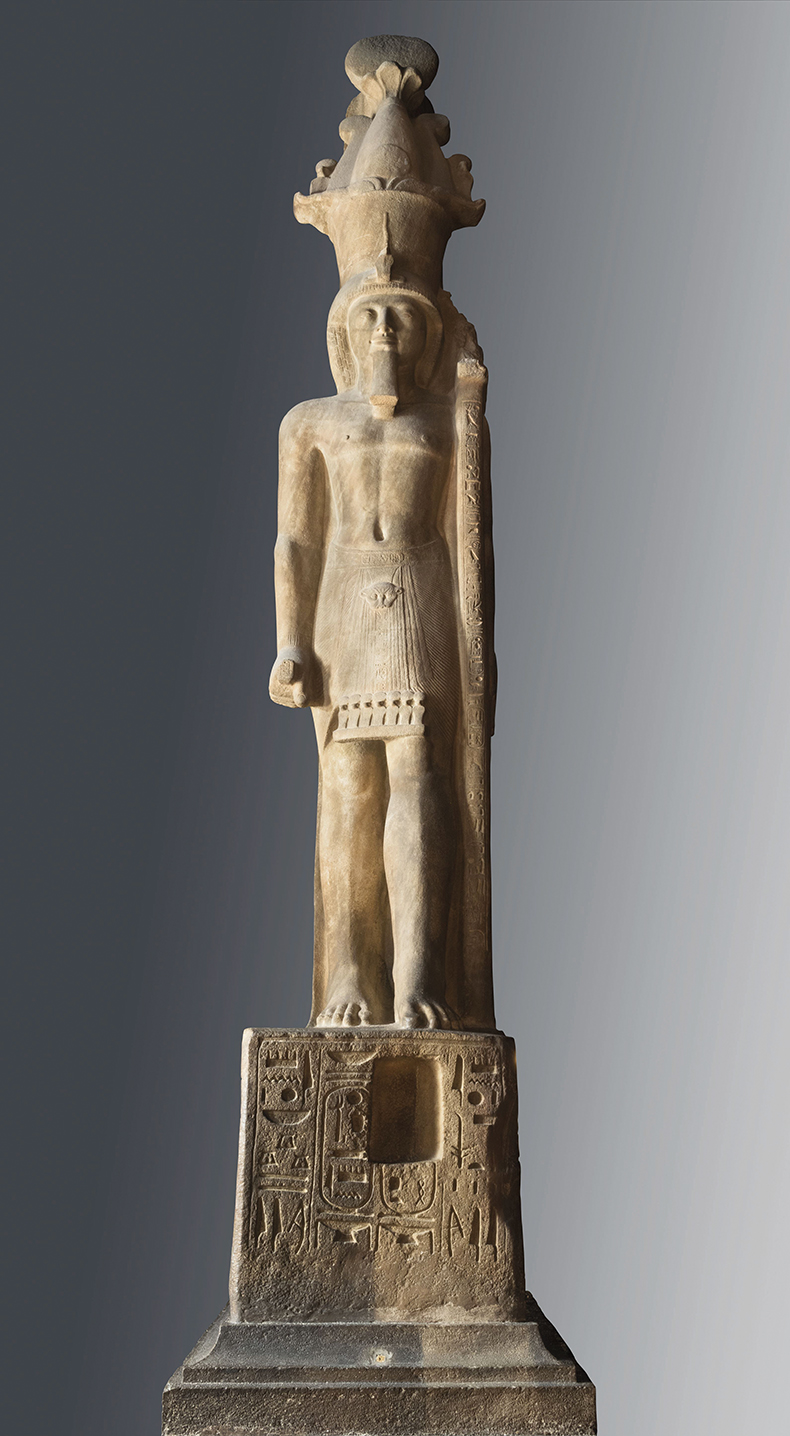
For most of 2024, the courtyard of Turin’s Museo Egizio (Egyptian Museum) has been full of scaffolding instead of straw, as it prepares to mark the 200th anniversary of its foundation. With more than a million visitors in 2023, the Museo Egizio has become one of Italy’s most-visited museums since its reopening in 2015, after a major expansion and refurbishment overseen by Isolarchitetti, the eminent Turin studio founded by Aimaro Isola. The museum is more than halfway through a 30-year agreement with the Italian state, under which it operates as a private foundation, with greater freedom in hiring and fundraising practices than a purely state-run institution would be.
To mark its bicentenary, the Foundation has embarked on an ambitious programme of works, to be completed in 2025. It commissioned Rotterdam-based firm OMA to cover the 17th-century courtyard with a glass roof and create a new suite of rooms underground. These include a new ticket hall and shop and an immersive room for digital displays, such as a specially commissioned film of the Nile that aims to transport visitors to an ancient landscape. Orientalising fantasies of a ‘timeless’ Egypt can be hard to shake: OMA’s visualisation of the immersive room used scenes from Edwin Long’s An Egyptian Feast (1877) to illustrate it, perhaps unaware that the painting is steeped in the racialised hierarchies of colonialism, as its inclusion in the Royal Academy’s ‘Entangled Pasts’ exhibition earlier this year demonstrated.
Due to be finished in 2025, the covered courtyard – renamed the Piazza Egizia – will be open to the public outside museum hours and for free. This includes access to the rock-cut temple of Ellesiya, given by Egypt to Italy for its role in UNESCO’s campaign to relocate Nubian temples threatened by the construction of the Aswan High Dam in the 1960s. On its ground floor, the museum has also created a new gallery of material culture, using a deluxe version of open storage (think pottery vases piled high) to interpret ancient materials and technologies, and revamped the spaces occupied by Seti II and his stone companions. This vaulted double-hall of statues, or statuario, has been a fixture since the museum’s first curator, Giulio Cordero di San Quintino, announced its installation in November 1824. Two hundred years later, it has been readied for a visit by Italian president Sergio Mattarella, followed by a three-day festival celebrating all things ancient Egyptian in Turin.
The Hall of Statues depicted by Mark Nicolosino in 1832. Museo Egizio, Turin
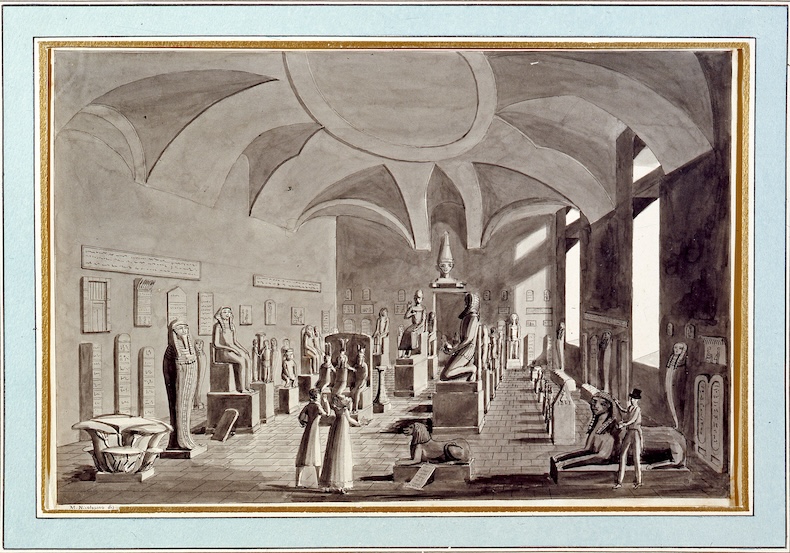
The city’s residents take great pride in the Museo Egizio, repeating its well-rehearsed claim to be the largest Egyptian museum in the world, after Cairo. Museums dedicated solely to Egyptian antiquities are rare. The most important collections outside Egypt are in encyclopaedic museums that regarded its ancient culture as a forebear to Western art (the Louvre, the Metropolitan Museum of Art) or found it too important to ignore (the British Museum). On the Italian peninsula, however, ancient Egypt had already found a second home in Roman times, from obelisks imported by emperors in triumph, to Egyptian cults and their resident priests, to Egyptian-style trends in art, gardens, and interior decoration. As a result, Italy has several Egyptian collections, some styled as museums (Florence in the past, the Vatican still). Italian even has a specific adjective, egizio, that distinguishes ancient Egypt from Egypt in general, egiziano.
With around 40,000 objects, Turin’s Museo Egizio is certainly the largest of its kind in Italy. It competed with collections in Berlin, Leiden, London and Paris to acquire Egyptian antiquities during and just after the Napoleonic wars. To that core, which included statues such as the long-suffering ‘Ozymandias’, later excavations added artefacts valued for their archaeological interest. The Museo Egizio is an impressive place, its displays as visually rich as its collections and housed in a building to match. It shares a brick-built baroque palazzo with the Academy of Sciences in the historic city centre – and how it got there is integral to the history of Turin and its one-time rulers, the Savoy dynasty.
Although Western interest in ancient Egypt is often credited to Napoleon’s invasion of Egypt in 1798, European powers were already familiar with the country’s illustrious past and its current prospects, namely mineral and metal wealth and a potential route from the Mediterranean to the Red Sea.
The Savoy court and the scholarly community of Turin were no different, and interests in collecting antiquities, studying the natural world and scoping out economic possibilities went hand-in-hand. To that end, Carlo Emanuele III sponsored the voyage of Vitaliano Donati, professor of botany at the University of Turin. Departing in 1759, Donati planned to travel through Egypt, Nubia, Sinai, Palestine and Syria, reaching India by land and returning by sea around Africa and through Gibraltar to arrive in Nice, part of Savoy territory until 1860. This grand voyage was cut short when Donati died in Mangalore (Mangaluru) in 1762. The crates of Egyptian antiquities he had left behind in Alexandria made the journey to Turin after his death, with his journal and drawings following a few years later through missionary channels.
Granodiorite statues of Isis and lion-headed Sekhmet, and a red granite statue of Rameses II, were the first monumental works of Egyptian art to reach the city. They were installed in the university museum along with a few objects on loan from the royal family, including an altar to the goddess Isis. During Napoleon’s occupation of Turin, the statues and Isis altar were among the artworks he had shipped to Paris, returning only in 1818.
Granodiorite statue of Rameses II (r. 1279–13BC) brought to Italy from Luxor by Bernardino Drovetti. Museo Egizio, Turin
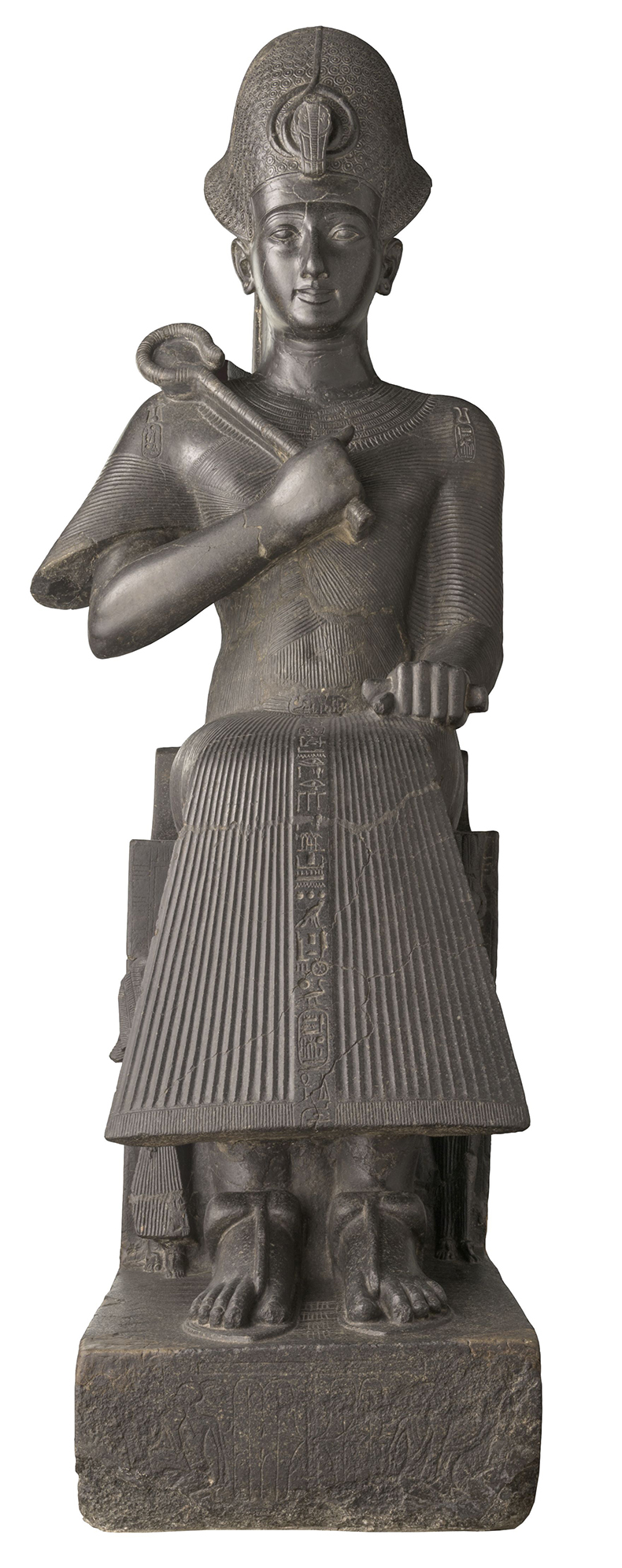
Napoleon’s campaign of 1798–1801 in Egypt ushered in a new wave of interest in the country’s ancient history, supported by an exodus of antiquities. The triumphant British forces sent war booty (including the Rosetta Stone) to London but allowed the French troops and savants to keep their notes, maps and drawings. The Ottomans were part of the victory as well, and once the Albanian Muhammad Ali had established himself as governor, or wali, he took up some of the ideas – and individuals – that Napoleon had left behind.
One of those was Bernardino Drovetti, son of a notary to the Savoy court, who finished his law degree in Turin during the Napoleonic occupation and almost immediately enrolled in the French army, to his father’s dismay. Drovetti proved to have military skill, diplomatic nous and an eye for an opportunity. In 1802 Napoleon himself tasked Drovetti with representing French interests at Muhammad Ali’s court, and he survived the emperor’s fall to continue as French consul in Egypt under the Bourbon restoration. The Piedmontese proved indispensable as a fixer for the agricultural, engineering and industrial projects Muhammad Ali devised to maximise income from his territory; the men are said to have become close friends. Drovetti solicited investment and expertise from Europe and enriched himself in the process. With the blessing of the wali, he also formed the largest collection of Egyptian antiquities of the time. Drovetti’s agents included the sculptor Jean-Jacques Rifaud (whose name is chiselled into many sphinxes and statues in Turin), the mineralogist Frédéric Cailliaud and a fellow Piedmontese, Antonio Lebolo. They travelled as far as Nubia, but the tombs and temples of Luxor were their most fruitful hunting grounds.
An 1819 lithograph of Bernardino Drovetti (with arm outstretched), surrounded by a group of Egyptians and Europeans measuring a colossal head using a plumb line. British Museum, London. Photo: © The Trustees of the British Museum

The collection was not for Drovetti’s own pleasure, but for sale – and he offered it to the city he had left 25 years earlier. Drovetti began negotiating with the Savoy rulers as early as 1820, and when, in 1821, Carlo Felice replaced his brother Vittorio Emanuele I on the throne (a liberal revolution forced the latter’s abdication), he honoured the agreed price of 400,000 lire over the protests of his finance ministry. Recent research by the Museo Egizio’s archivists suggests that no one knew exactly what they were buying until late in the negotiations, and not everything tallied once the crates were opened; Drovetti may have held some things back to sell to France. Still, what was waiting in storage at the port of Livorno did not disappoint Cordero di San Quintino, who was sent in early 1824 to compile an inventory and appointed the first curator of the museum. He arranged the display so professionally, he wrote to a friend later that year, that even the French would want to come and see it.
One Frenchman in particular made the trip: Champollion, who had already flattered Drovetti with a letter proclaiming, ‘The road to Memphis and Thebes passes through Turin.’ Welcomed warmly by the Academy of Sciences – which had been put in charge of the collection – and in society circles, Champollion spent months deep in study of the collection, especially the papyri, many of which were still rolled up in scrolls. Not all had been so lucky, however. What proved to be one of the most significant texts for Egyptian history, the Turin Canon or King List, was in fragments when Champollion unpacked it. Still, he recognised that it charted centuries of Egyptian rulers and the years they reigned, starting with the mythical era of gods and ending just before the New Kingdom, when it was written.
Champollion was less impressed by Cordero di San Quintino, with whom he clashed over access. The sardonic ‘Ozymandias’ petition took aim at the Italian curator’s progress in cataloguing the collection and organising the first displays, which was a monumental task in every sense. When the museum did open to the public, however, it was a success, and in 1832, it passed out of the Academy’s control to become the Royal Museum of Antiquity and Egypt. The university’s Donati collection joined the ground and first-floor galleries in the College of the Nobles. An ink-wash drawing from around this time shows coffins, stelae, framed papyri and royal statues arranged in rows under the vaulted ceiling and bathed in sunlight from tall windows at one side. A man in top hat and cutaway coat strokes a winsome sphinx, and a woman visitor holds a guidebook while her male companion gestures towards the centre of the room. There, the museum’s most famous statue, a seated dark stone figure of Rameses II in a crisply pleated gown (part of Drovetti’s hoard), holds pride of place. Champollion characterised it as the Apollo Belvedere of Egyptian art and declared himself in love with it.
In the Hall of Statues: the granodiorite statue of Rameses II (r. 1279–13BC) brought to Italy from Luxor by Bernardino Drovetti. Museo Egizio, Turin. Photo: courtesy OMA and Andrea Tabocchini Architecture; © Marco Cappelletti

When Carlo Felice insisted on buying Drovetti’s collection, it’s unclear if he knew about earlier Savoy interests in Egypt. The Dukes had moved their capital to Turin in the 1500s, from their ancestral home at Chambéry in what is now France. To mark the occasion, and flatter their dynastic ambitions, court historian Count Filiberto Pingone published a history of Turin in 1577. He credited its founding to an Egyptian prince named Eridano, who crashed his chariot into the River Po and was reminded of the Nile. In antiquity, Turin had been a Roman military camp, and the discovery of a statue base inscribed for the goddess Isis lent weight to Pingone’s tale, which was repeated by historian Emanuele Tesauro in his Historia dell’augusta città di Torino in 1679. By then, Duke Carlo Emanuele I had set aside a palace gallery to display the Savoy collection of Greek and Roman antiquities, many excavated in and around the city. He also acquired the Mensa Isiaca, the altar to Isis in stunning bronze inlaid with silver, copper and tinted alloys. Dating to the Roman empire, the altar had been found in Rome and was part first of Cardinal Bembo’s collection, then the collection of the Gonzaga dukes of Mantua, from whom Carlo Emanuele I acquired it.
The Mensa Isiaca joined the Donati and Drovetti collections in the Egyptian Museum when it received its royal designation in 1832, and the museum’s fortunes continued to follow those of Turin and the Savoys from then on. Vittorio Emanuele II became the first king of a united Italy in 1861, and although Turin lost its status as national capital in 1864 (to Florence, then to Rome), it remained an important cultural and industrial centre. The new discipline of Egyptology took shape at the same time, benefiting from the links men like Drovetti had fostered between Europe and Egypt’s Ottoman rulers. By the time the Suez Canal opened in 1869, Italians were the second largest foreign population in Egypt, after decades of immigration spurred by economic opportunities in Alexandria, Cairo and the canal zone. Bust followed boom, however, and in 1882, Britain invaded and occupied to counter a rebellion against the Ottoman viceroy and ensure that Egypt’s European debts were paid. Austerity measures introduced by the British prompted the French-run antiquities service to introduce a system of partage to encourage externally financed excavations, allowing foreign institutions to keep around half of what they found.
In Turin, the far-sighted new director of the Egyptian Museum, Ernesto Schiaparelli, was well aware of these developments, having done his doctorate in Paris with the man who became head of the Egyptian antiquities service in 1881, Gaston Maspero. Born in Piedmont, Schiaparelli came from a well-to-do family of scholars (fashion designer Elsa was a second cousin) and combined his career in Egyptology with Catholic charitable work, supporting Italian missionaries and emigrants abroad. With Maspero’s approval and the patronage of King Vittorio Emanuele III, Schiaparelli created an Italian Archaeological Mission based at the museum in Turin. The excavations it carried out between 1903 and 1920 quadrupled the size of the collections and revived its international prestige.
Today, finds from these excavations dominate the displays, research and historical narrative of the Museo Egizio, in ways the scholars of Champollion’s day could not have imagined. At the sites of Gebelein and Asyut, the Italian archaeologists found unprecedented burials from the transitional period between the Old and Middle Kingdoms. From the New Kingdom village of Deir el-Medina – home to the artists who decorated royal tombs – the museum in Turin received the entire contents of the tomb of an architect named Kha and his wife Merit, yielding stunning furniture, textiles and personal items as well as their wrapped and embalmed bodies, kept intact. For whatever reason, Schiaparelli waited until 1927 to publish the 1906 discovery. He may have been encouraged by publicity surrounding Tutankhamun in the 1920s.
Box decorated with offering scenes for Kha and Merit, containing loincloths and other linen, Egypt, New Kingdom, 1425-1353 BC, Museo Egizio, Turin
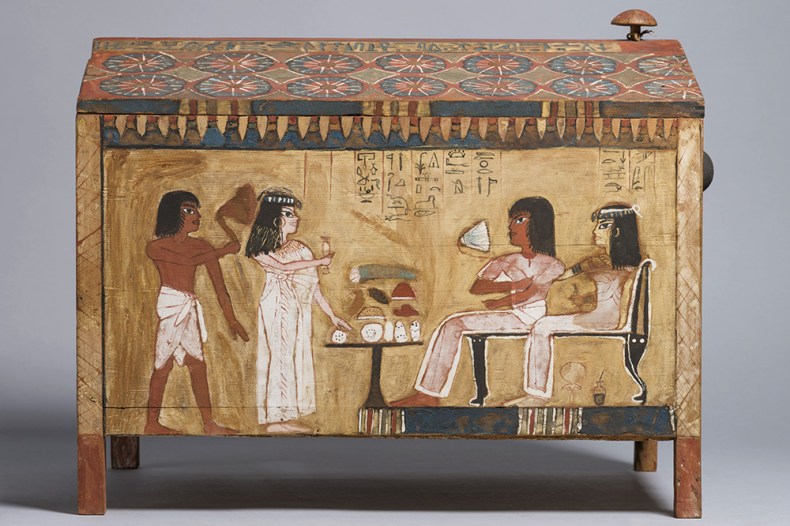
By then, Italy had fallen under the spell of Fascism, which casts a shadow over the history of the Museo Egizio as well. From 1913 into the 1930s, the museum’s excavations included Turin professor of anthropology Giovanni Marro and embraced the era’s scientific racism. Marro, who founded the university’s Museum of Anthropology and Ethnography, collected thousands of skeletal remains from Egyptian sites and took photographs of Egyptian men and boys in the style used to characterise ethnographic ‘types’. He was a fervent admirer of Hitler and Mussolini, but colonialism and the Fascist era remain sensitive subjects in Italian public discourse and cultural institutions. Although a smattering of wall texts in the Museo Egizio mention the colonial context in which collecting and archaeology took place, reticence to confront the politics of the past may in part be due to the politics of today.
In the new hall of statues designed by OMA and the curatorial team, the Museo Egizio does take a small step towards countering the erasure of modern Egyptians in Western Egyptology, courtesy of a new work by Netherlands-based Egyptian artist Sara Sallam. The redisplay of this ‘Gallery of Kings’ does away with the glitzy mirrors installed in 2006 by film designer Dante Ferretti, which proved more popular with Instagrammers than archaeologists. Signposting in classical Arabic is another gesture towards the Egyptian origin of the collection, and to the presence of a large Arabic-speaking diaspora in Italy. The slogan adopted for the bicentenary – ‘Memory is our future’ – leaves the question of whose memory, and for whose future, unspecified.
Nonetheless, Seti II (‘Ozymandias’) will not be able to complain about his comfort in the latest renovations of this remarkable museum. Visitors may even find themselves, like Champollion, falling a little bit in love with the serene face of Rameses II, or the gleaming metal of the Mensa Isiaca – not to mention the subalpine city that they now call home.
View of the Museo Egizio’s new gallery of material culture, full of pottery. Photo: courtesy Museo Egizio
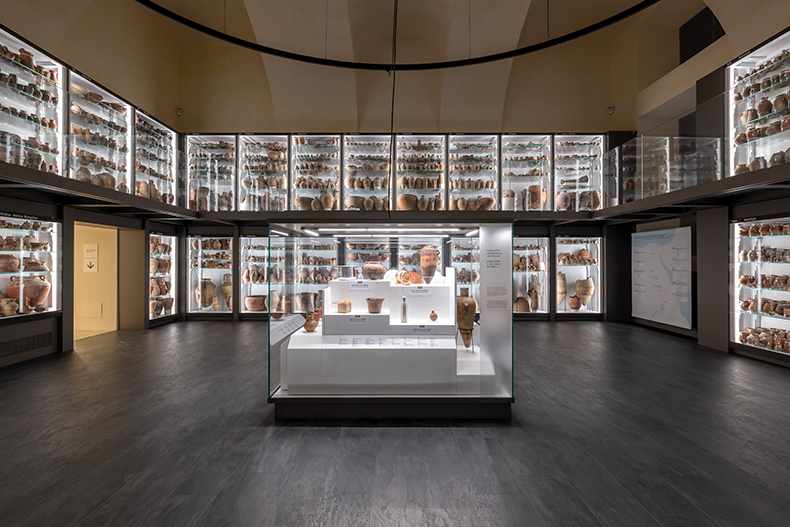
From the December 2024 issue of Apollo. Preview and subscribe here.


